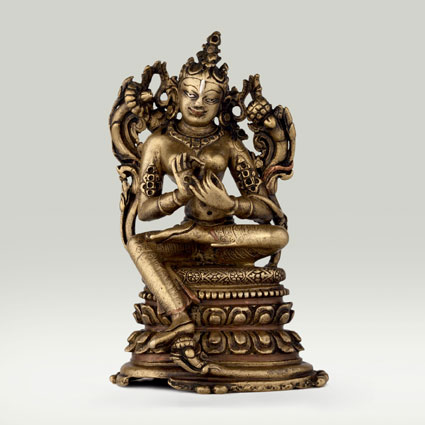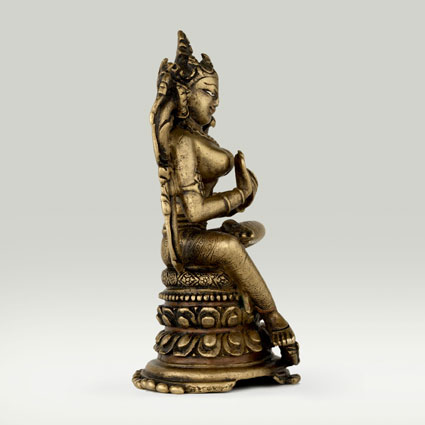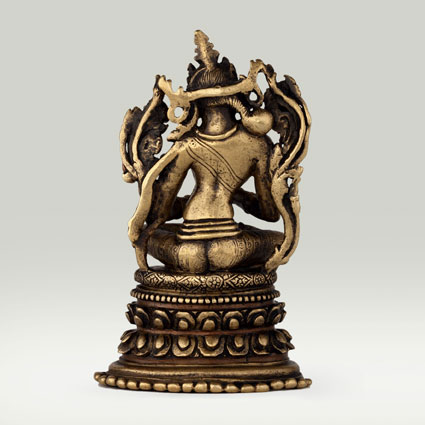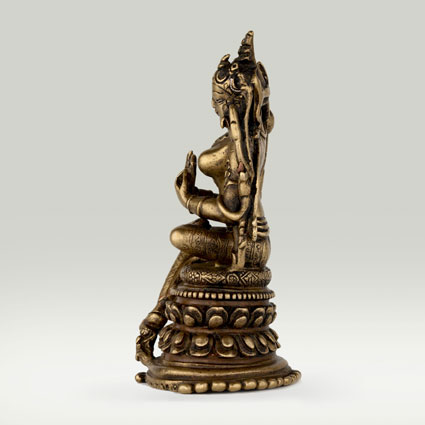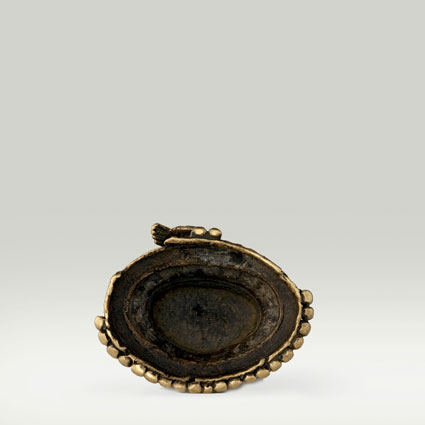Mahashri Tara – The "Most Glorious Tara"
See it in the Museum

India and Nepal
Orientation 3
Display 4

ABS 024
Code: ABS 024
Country: India (north-east)
Style: Late Pala Style
Date: 1100 - 1200
Dimensions in cm WxHxD: 6.8 x 11.3 x 5.3
Materials: Brass; inlaid with silver and copper
Mahashri Tara – The "Most Glorious
Tara"
Mahashri Tara or "most glorious liberator" is a less common form of the goddess, which can be recognized by the gesture of “setting the wheel of law in motion,” which she alone performs. Both hands seize the stalk of lotus flowers blossoming by her face. Sitting in the ease posture, she appears adorned with the royal ornaments proper to the divine manifestations. Her eyes and urna are inlaid with silver, her lips with copper. An unusual detail is that she is seated on an elaborate cushion above the double lotus seat. Usually found in Buddha statues, this cushion symbolizes the kusha grass on which Siddhartha sat under the Bodhi tree in his quest toward Enlightenment.
Tara, “the Liberator” or “Saviouress” is one of the most famous goddesses of Indo-Tibetan Buddhism. As a bodhisattva, she pledged to continuously take birth as a woman until she reaches complete Buddhahood. She appears under multiple aspects among which the Green Tara, the White Tara, and the 21 manifestations are the most popular in Tibet.
Mahashri Tara or "most glorious liberator" is a less common form of the goddess, which can be recognized by the gesture of “setting the wheel of law in motion,” which she alone performs. Both hands seize the stalk of lotus flowers blossoming by her face. Sitting in the ease posture, she appears adorned with the royal ornaments proper to the divine manifestations. Her eyes and urna are inlaid with silver, her lips with copper. An unusual detail is that she is seated on an elaborate cushion above the double lotus seat. Usually found in Buddha statues, this cushion symbolizes the kusha grass on which Siddhartha sat under the Bodhi tree in his quest toward Enlightenment.
Tara, “the Liberator” or “Saviouress” is one of the most famous goddesses of Indo-Tibetan Buddhism. As a bodhisattva, she pledged to continuously take birth as a woman until she reaches complete Buddhahood. She appears under multiple aspects among which the Green Tara, the White Tara, and the 21 manifestations are the most popular in Tibet.

